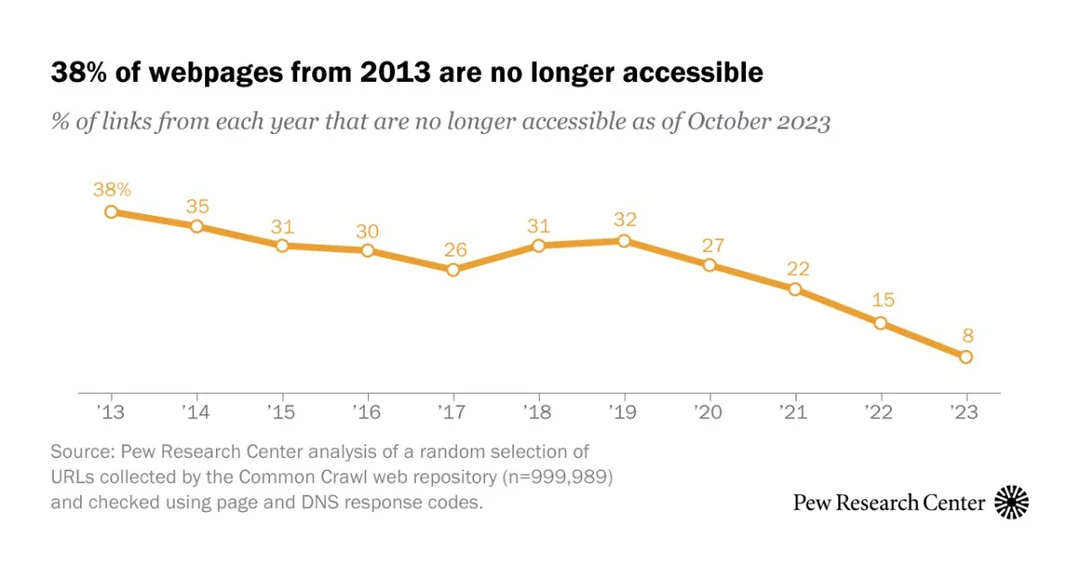
The Digital Decay Problem
The internet is often seen as a vast, permanent archive of information. However, the reality is far different—38% of webpages that existed in 2013 are no longer accessible a decade later. That means more than one-third of the web has disappeared due to domain expirations, abandoned websites, or shifts in technology.
Yet, a bigger concern than disappearing webpages is the way businesses and organizations now rely almost exclusively on social media for their web presence. Instead of maintaining their own websites, many companies now use Facebook, Instagram, or LinkedIn as their primary digital identity—often at the expense of control, accessibility, and longevity.

The Social Media Trap: Dependency & Risk
While social media platforms offer convenience, they should not replace a dedicated website. Here’s why:
- Lack of Ownership & Control – Businesses that rely solely on social media do not own their digital presence. A policy change, algorithm update, or account suspension can wipe out years of engagement overnight.
- Exclusivity & Barriers – More than 28% of internet users do not actively use social media. By requiring customers to interact via platforms like Facebook or Instagram, businesses exclude a significant audience.
- Declining Organic Reach – In 2013, Facebook’s average organic reach for business pages was 12.05%. By 2023, it had dropped to 2.2%. This means businesses must now pay for visibility even among their own followers.
- Data Vulnerability – Over 533 million Facebook accounts were exposed in a data breach in 2021. Relying on third-party platforms puts customer and business data at risk.

The Smart Approach: A Balanced Web Footprint
A strong web presence isn’t about abandoning social media—it’s about diversifying and owning your digital real estate. Here’s how businesses can build a sustainable web strategy:
1. Own Your Domain & Website – A professional website is the foundation of your digital identity. It provides a permanent, controlled space where customers can find accurate and up-to-date information.
2. Use Social Media as a Marketing Tool, Not a Primary Presence – Platforms like Facebook and Instagram are great for engagement, but they should drive traffic back to a website, not replace it.
3. Ensure Accessibility & Independence – Not all customers want to interact via social media. A publicly available website allows anyone to access business information without requiring a third-party account.
4. Optimize for Searchability – A dedicated website improves Google search rankings, making it easier for potential customers to find a business organically. 75% of users never scroll past the first page of search results, meaning a strong web presence is essential.
5. Leverage Multi-Channel Strategies – Email newsletters, blog content, and industry directories can supplement a website and reduce over-reliance on social media.
Businesses that depend solely on social media are leaving their digital future in the hands of third-party corporations. Don’t let your brand become a casualty of changing algorithms or policy shifts.
Shifting Towards a Content Generation Strategy
A website is more than just a digital business card—it should be an active content hub that keeps visitors engaged and coming back. The key to long-term success is regular content generation that provides value, builds trust, and positions a company as an industry leader.
Here’s how businesses can create a content strategy that drives traffic and engagement:
Blogging for Authority & SEO – Businesses that blog regularly get 55% more website visitors and 97% more inbound links than those that don’t. Publishing how-to guides, industry insights, case studies, and expert opinions keeps audiences engaged and improves search rankings.
News & Updates – Companies should regularly update their websites with new services, product launches, event announcements, and company news to maintain relevance.
Educational Content & Resources – Offering free eBooks, whitepapers, webinars, and FAQs can position a business as an industry expert and attract repeat visitors.
Customer Stories & Testimonials – Showcasing real-world success stories builds trust and credibility, encouraging new customers to engage.
Interactive Content – Tools like quizzes, surveys, and interactive calculators can improve user engagement and keep visitors on a site longer.
Email Marketing Integration – 91% of consumers check their email daily, making newsletters an essential way to distribute content and drive visitors back to the website.
By prioritizing high-quality, consistent content, businesses can build a loyal audience, improve brand recall, and generate more leads—all while maintaining control over their digital presence.
Take Control of Your Online Presence
Businesses that depend solely on social media are leaving their digital future in the hands of third-party corporations. Don’t let your brand become a casualty of changing algorithms or policy shifts.
If your business needs help building a strong, independent, and sustainable web presence, my consultancy can help. We specialize in:
✅ Custom Website Development – Creating professional, SEO-optimized websites tailored to your brand.
✅ Content Strategy & Blogging – Developing valuable content to attract visitors and improve engagement.
✅ Digital Marketing & SEO Optimization – Ensuring your business ranks higher in search results and drives more organic traffic.
📩 Contact us today to create a web strategy that puts you in control and ensures long-term digital success!








